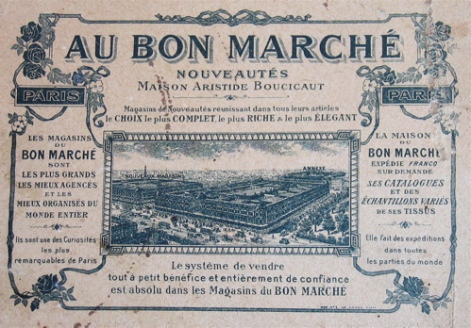Michael B. Miller, The Bon Marché: Bourgeois Culture and the Department Store, 1869-1920
The Founding of Bon Marché
IN THE LATE PARISIAN SUMMER of 1869 several men, and one woman, gathered near the junction of the sixth and seventh arrondissements to witness the laying of a cornerstone. It is unlikely they had come a great distance that particularly warm day, since many Parisians, including the well-to-do, still lived in or near their shops, workshops, or offices. Yet if some had come a certain distance, even from the opposite right bank, their journey could not have been a difficult one. No longer was Paris an impassable maze of streets and

alleyways, too narrow to accommodate the traffic of a mid-century capital, too haphazard in design to permit cross-town circulation. Now the broad boulevards that Baron Haussmann had built cut through Paris along a rational plan that effectively removed those barriers to intra-city travel that for centuries had confined Parisians to their immediate quarter or that rendered unpleasant any effort to shuttle about. Indeed if our travellers had desired, they might have come in one of the carriages of the Compagnie Generale des Omnibus that now moved through the city streets with relative ease. In the meantime, those who came on foot might have walked to the ceremony along the new Rue de Rennes or on the path of the soon to be built Boulevard Raspail which would pass near the new building's site.
Their presence was not noticed by the press that day. More important matters-the emperor's health, the constitutional reforms just recently granted, the meeting of the International Association of Workingmen at Basel -- were the stories that preoccupied the public mind on September 9 and 10. Little attention could be devoted to the erection of a new building at a time when fundamental transitions seemed both possible and immediate.
In such a setting and such a mood we might well imagine the scene as Aristide Boucicaut, his wife, and his principal associates laid the cornerstone for the first department store in France. To be sure, the old Bon Marche that the new building was replacing already covered a substantial floor-space and supported a substantial sales volume of more than twenty million francs a year. 1 Nor was the Bon Marche the only Parisian store in 1869 that could boast of generous dimensions and bountiful sales. Yet what was significant about this particular moment in September was that for the first time a store was being constructed that was formally conceived and systematically designed to house a grand magasin. Prone at times to exaggerate, Boucicaut would be nothing less than cand1d when a few years later he would distinguish the first completed section of the new building from its rivals and the Bon Marche's own past with the proclamation that his was now "the only [store] specifically constructed and entirely intended for a great trade in nouveautes." 2